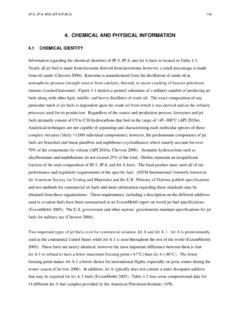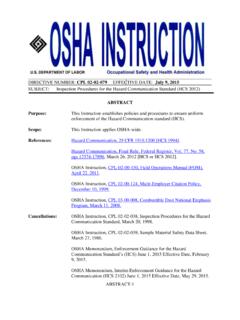Transcription of HYDROCARBONS, BP 36°-216 °C 1500
1 HYDROCARBONS, BP 36 -216 C 1500. FORMULA: table 1 MW: table 1 CAS: table 1 RTECS: table 1. METHOD: 1500, Issue 3 EVALUATION: PARTIAL Issue 1: 15 August 1990. Issue 3: 15 March 2003. OSHA : table 2 PROPERTIES: table 1. NIOSH: table 2. ACGIH: table 2. COMPOUNDS: cyclohexane n-heptane n-octane (Synonyms in table 1) cyclohexene n-hexane n-pentane n-decane methylcyclohexane n-undecane n-dodecane n-nonane SAMPLING MEASUREMENT. SAMPLER: SOLID SORBENT TUBE [1] TECHNIQUE: GAS CHROMATOGRAPHY, FID [1]. (coconut shell charcoal, 100 mg/50 mg). ANALYTE: Hydrocarbons listed above FLOW RATE: table 3. DESORPTION: 1 mL CS2 ; stand 30 min VOL-MIN: table 3. -MAX: table 3 INJECTION. VOLUME: 1 L. SHIPMENT: Routine TEMPERATURES. SAMPLE -INJECTION: 250 C. STABILITY: 30 days @ 5 C -DETECTOR: 300 C. -COLUMN: 35 C (8 min) - 230 C (1 min).
2 BLANKS: 10% of samples ramp ( C /min). CARRIER GAS: Helium, 1 mL/min ACCURACY. COLUMN: Capillary, fused silica, 30 m x RANGE STUDIED: table 3 ID; m film 100% dimethyl polysiloxane BIAS: table 3. CALIBRATION: Solutions of analytes in CS 2. OVERALL PRECISION ( r T ): table 3. RANGE: table 4. ACCURACY: table 3. ESTIMATED LOD: table 4. PRECISION ( r ): table 4. APPLICABILITY: This method may be used for simultaneous measurements; however, interactions between analytes may reduce breakthrough volumes and alter analyte recovery. INTERFERENCES: At high humidity, the breakthrough volumes may be reduced. Other volatile organic solvents such as alcohols, ketones, ethers, and halogenated hydrocarbons are potential interferences. OTHER METHODS: This method is an update for NMAM 1500 issued on August 15, 1994 [2] which was based on methods from the 2nd edition of the NIOSH Manual of Analytical Methods: S28, cyclohexane [3]; S82, cyclohexene [3]; S89, heptane [3].
3 S90, hexane [3]; S94, methylcyclohexane [3]; S378, octane [4]; and S379, pentane [4]. NIOSH Manual of Analytical Methods (NMAM), Fourth Edition HYD RO CAR BO NS, BP 36-216 C : MET HO D 150 0, Issue 3, dated 15 M arch 200 3 -Page 2 of 8. REAGENTS: EQUIPMENT: 1. Eluent: Carbon disulfide *, low benzene, 1. Sampler: glass tube, 7 cm long, 6-mm OD, chrom ato graphic quality. 4-mm ID, flame-sealed ends, containing two 2. Analytes, reage nt gra de.* sections of activated coconut shell charcoal 3. Helium, prepurified and filtered. (front = 100 mg, back = 50 mg) separated by 4. Hydrogen, prepurified and filtered. a 2-mm urethane foam plug. A silylated glass 5. Air, prepurified and filtered. wool plug precedes the front section, and a 3-mm urethane foam plug follows the back section. Tubes are comm ercially available.
4 * See SPECIAL PRECAUTIONS 2. Personal sampling pumps ( to L/min, table 3) with flexible tubing. 3. Gas chromatograph, FID, integrator, and a Rtx-1 or equivalent capillary column (page 150 0-1). 4. Glass a utos am pler vials (2-m L) with PTFE-lined caps. 5. Pipettes (1-mL) and pipette bulb. 6. Syringes (10, 25, 100, and 250 L). 7. Volum etric flasks (10-m L). SPECIAL PRECAUTIONS: Carbon disulfide is tox ic and extre m ely flam m able (flash point = -30 C ). Prepare samples and standards in a well-ventilated hood. SAMPLING: 1. Calibrate each personal sampling pump with a representative sampler in line. 2. Break the ends of the sam pler im m ediately before sa m pling. Attach the sampler to a personal sampling pump with flexible tubing. 3. Sa m ple at an accurately known flow rate between and L/min ( to L/m in for n-pentane).
5 For a total sample size as shown in table 3. 4. Ca p the sam plers with plastic (not rub ber) cap s an d pa ck sec urely for shipm ent. SAMPLE PREPARATION: 5. Place the front and back sorbent sections of the sampler tube in separate vials. Include the glass wool plug in the vial with the front sorbent section. Discard the foam plugs. 6. Ad d m L carbon disulfide to each vial. Attac h crim p cap to each vial im m ediate ly. 7. Allow to stand at least 30 min with occasional agitation. CALIBRATION AND QUALITY CONTRO L: 8. Ca librate daily with at leas t six wo rking standa rds from below the LOD to 10 times the LO Q. Additional sta ndards m ay be added to exte nd the calibra tion curve if ne cessary. a. Add known amounts of analytes to carbon disulfide in 10-mL volumetric flasks and dilute to the mark.
6 Prepare additional standards by serial dilution in 10-mL volumetric flasks. b. Analyze with samp les and blanks (steps 11 and 12). c. Prepare a calibration graph (pe ak area of analyte vs. g of analyte per sam ple). 9. Determine the desorption efficiency (DE) at least once for each batch of charcoal used for sampling in the calibra tion ran ge (s tep 8). a. Prepare three tubes at each of five levels plus three media blanks. b. Rem ove and disca rd the back sorbent sec tion of a med ia blank sam pler. NIOSH Manual of Analytical Methods (NMAM), Fourth Edition HYD RO CAR BO NS, BP 36-216 C : MET HO D 150 0, Issue 3, dated 15 M arch 200 3 -Page 3 of 8. c. Inject a know n am ount of stock solution (5 to 25 L) directly onto the front sorbent section with a microliter syringe. d. Allow the tubes to air equilibrate for several m inutes , then cap the tub es a nd a llow to stand overnight.
7 E. Deso rb (steps 5 through 7 ) and analyze with standards and blank s (steps 11a nd 12). f. Prepare a graph of DE vs. g analyte recovered. 10. Analyze at leas t three qua lity control blind spik es a nd three a nalyst spike s to ins ure th at the calibration grap h an d DE graph are in c ontro l. MEASUREMENT: 11. Set the gas chromatograph according to the manufacturer's recomm endations and to the conditions given on pag e 15 00-1 . Inject a 1- L aliquot manually using a solvent flushing technique or with an autosam pler. NOTE: If the pea k area is abo ve the linear ra nge of the working standard s, dilute w ith solve nt, reanalyze and apply the appropriate dilution factor in the calculations. Analyte Approximate Retention Time (min). n-pentane solvent (CS2) n-hexane cyclohexane cyclohexene n-heptane methylcyclohexane n-octane n-nonane n-decane n-undecane n-dodecane NOTE: Retention tim es m ay vary slightly due to column manufacturer and age of column, and be influen ced by other GC ins trum enta l param eters.
8 12. Measure the peak area. CALCULATIONS: 13. Determine the mass, g (corrected for DE), of analyte found in the sam ple front (W f) and back (W b). sorbent sec tions, and in the average m edia blank front (B f) and back (B b) sorbent sections. NO TE: If W b > W f / 10, report breakthrough and possible sample loss. 14. Calculate the concentration, C, of analyte in the air volume, V(L), sampled: NO TE : :g/L = m g/m 3. NIOSH Manual of Analytical Methods (NMAM), Fourth Edition HYD RO CAR BO NS, BP 36-216 C : MET HO D 150 0, Issue 3, dated 15 M arch 200 3 -Page 4 of 8. EVALUATION OF METHOD: Issues 1 and 2: Precisions and biases ( table 3) were determ ined by analyzing generated atm osphe res containing one-ha lf, one, and two times the OSHA standard. table 3 does not contain data for n-decane, n-dodecane and n- heptane since they were not evaluated previously.
9 Generated concentrations were independently verified. Breakthrough cap acities were de term ined in dry air. Storage stability was assessed at 7, 14, and 30 days. Measurement precisions ( table 4) were determined by spiking sampling media with amounts corresponding to one-half, one, and two times the OSH A standard for nominal air volumes. Desorption efficiencies for spiked sam plers con taining only one co m pou nd e xce ede d 75 % [2,3,4,8 ]. Issue 3: The desorption efficiency, at levels ranging from 10 times the LOQ to times the REL, was determined by spiking known am oun ts of analytes (in CS 2) on coconut shell charcoal tubes. All analytes exhibited accepta ble desorption efficiency recovery results at six levels evaluated. Each analyte was evaluated for its storage stability. Sorbent tubes were spiked at approximately 100 g and stored in a drawer for 7 days, then transferred to a refrigerator at 5 C.
10 Samples were analyzed after 7, 14, and 30 days. A ll analyte s had accepta ble rec overies (>9 0% ), except cyc lohexene, which had a 30 day recovery of 85% [1]. REFERENCES: [1] Pende rgrass SM and M ay L, Backup Data R eport, ACS /CEM B/DAR T/NIO SH (19 99). [2] NIOSH[1994]. Hydrocarbons, BP 36-136 C. In: Eller PM, ed. NIOSH M anual of Analytical Methods, 4th rev. ed. Cincinnati, OH: Department of Health and Human Services, Public Health Service, Centers for Disease Control, National Institute for Occupational Safety and Health, DHHS (NIOSH). Publication No. 94-113. [3] NIOSH M anual of Analytical Methods, 2nd. ed., V. 2, S28, S82, S89, S90, S94, Department of Health, Educa tion, and W elfare, Publ. (NIOSH ) 77-157-B (19 77). [4] NIOSH M anual of Analytical Methods, 2nd. ed., V. 3., S378, S379, Department of Health, Educa tion, and W elfare, Publ.













